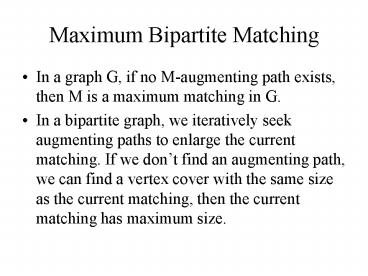Maximum Bipartite Matching - PowerPoint PPT Presentation
1 / 14
Title:
Maximum Bipartite Matching
Description:
For each xy E(G), include y in T and include w in S, where yw E(G). Mark x and Goto Step 2. ... graph produces a matching and a vertex cover of equal size ... – PowerPoint PPT presentation
Number of Views:528
Avg rating:3.0/5.0
Title: Maximum Bipartite Matching
1
Maximum Bipartite Matching
- In a graph G, if no M-augmenting path exists,
then M is a maximum matching in G. - In a bipartite graph, we iteratively seek
augmenting paths to enlarge the current matching.
If we dont find an augmenting path, we can find
a vertex cover with the same size as the current
matching, then the current matching has maximum
size.
2
Algorithm 3.2.1
- Input An X,Y-bigraph G, a matching M in G, and
the set U of M-unsaturated vertices in X. - Output Output an M-augmenting path or a vertex
cover of size M.
3
Algorithm 3.2.1
- Exploring M-alternating paths from U, letting S?X
and T?Y be the sets of vertices reached. Marking
vertices of S that have been explored for path
extensions.
4
Algorithm 3.2.1 (2/2)
- 1. SU and T?.
- 2. If S has no unmarked vertex, stop and report
T?(X-S) as a minimum cover and M as a maximum
matching. - 3. Explore alternating path from an unmark x?S.
- 3.1. If there exists unsaturated y?N(x) such
that xy?M, then stop and report an M-augmenting
path from U to y. - 3.2. For each xy?E(G), include y in T and
include w in S, where yw?E(G). Mark x and Goto
Step 2.
5
Theorem 3.2.2
- Repeatedly applying Algorithm 3.2.1 to a
bipartite graph produces a matching and a vertex
cover of equal size - 1. Let QT?(X-S) and M be the matching when
algorithm 3.2.1 stops at step 2. - 2. No edge joins S to Y-T. ? Q is a vertex cover.
- 3. Each y?T is M-saturated.
- 4. Each vertex of X-S is M-saturated.
- 5. No edge in M joins T to X-S.
- 3.4. 5. ? M has at least TX-S edges. ? Q is
a minimum vertex cover and M is a maximum
matching.
6
Time Complexity of Algorithm 3.2.1
- Let G be an X,Y-bigraph with n vertices and m
edges. - 1. Algorithm 3.2.1 executes at most n/2 times
since ?(G)ltn/2. - 2. Each execution of Algorithm 3.2.1 considers
each edge at most once. - ? The execution time of Algorithm 3.2.1 is O(mn).
7
Maximum Weighted Bipartite Matching and Minimum
Weighted Cover (Dual Problems)
- A farming company owns n farms and n processing
plants. The profit that results from sending the
output of farm i to plant j is wi,j. The company
wants to select edges forming a matching to
maximize total profit. - The government will pay ui if the company agrees
not to use farm i and vj if it agrees not to use
plant j. The government must offer amounts such
that uivjgtwi,j for all i, j. Otherwise, the
company makes more by using edge xiyj than taking
the government payments for those vertices. The
government wants to minimize ?ui?vj.
8
Lemma 3.2.7
- For a perfect matching M and weighted cover (u,v)
in a weighted bipartite graph G, (1)
c(u,v)gtw(M), and (2) c(u,v) w(M) iff M consists
of edges xiyj such that uivjwi,j. In (2), M and
(u,v) are optimal. - (1) c(u,v)gtw(M) since uivjgtwi,j for all i, j.
- (2) Trivial.
9
Equality Subgraph
- Equality Subgraph The equality subgraph Gu,v for
a weighted cover (u,v) is the spanning subgraph
of Kn,n whose edges are the pairs xiyj such that
uivjwi,j. In the cover, the excess for i,j is
uivj-wi,j.
10
Algorithm 3.2.9
- Input A matrix of weights on the edges of Kn,n
with bipartition X,Y. - Output A maximum weighted matching.
- Idea Iteratively adjusting the cover (u,v) until
the equality subgraph Gu,v has a perfect
matching. - Initialization Let (u,v) be a cover, such that
uimaxj wi,j and vj0.
11
Algorithm 3.2.9
12
Algorithm 3.2.9
- 1. Find a maximum matching M in Gu,v. If M is
perfect matching, stop and report M as a maximum
weighted matching. - 2. Let Q be a vertex cover of size M in Gu,v.
Let RX?Q and TY?Q. Leteminuivj- wi,j
xi?X-R, yj?Y-T. - 3. Decreases ui byefor xi ?X-R, and increases vj
byefor yj ?Y. - 4. Form the new equality graph and Goto Step 1.
13
Theorem 3.2.11
- Algorithm 3.2.9 finds a maximum weight matching
and a minimum cost cover - 1. Let (u,v) be the current cover and suppose
that the equality subgraph has no perfect
matching. Let (u,v) be the new lists of numbers
assigned to the vertices. - (1) uivj uivj for edges xiyj from X-R to
T or from R to Y-T. - (2) uivj uivje for edges xiyj from R to
T. - (3) uivj uivj-e for edges xiyj from X-R
to Y-T. - ? (u,v) is a cover since eminuivj- wi,j
xi?X-R, yj?Y-T.
14
Theorem 3.2.11
- 2. It terminates only when the equality subgraph
has a perfect matching. ? equal value for the
current matching and cover. - 3. M is not a perfect matching. ? QMltX. ?
RTltX-RR. ? TltX-R. ? at each
iteration the cost of the cover is reduced at
least e. ? algorithm 3.2.9 terminates since the
cost starts at some value and is bounded below by
the weight of a perfect matching.































